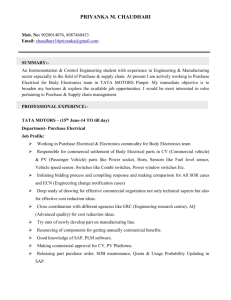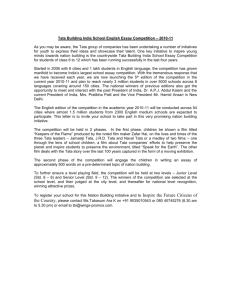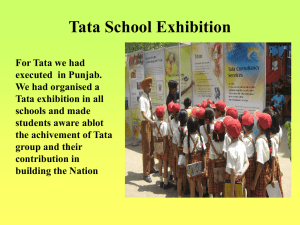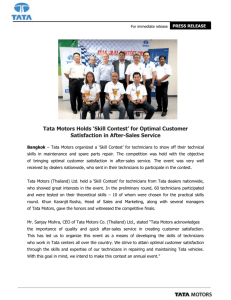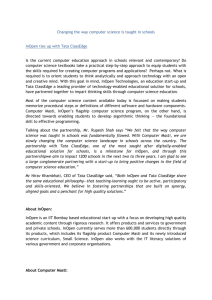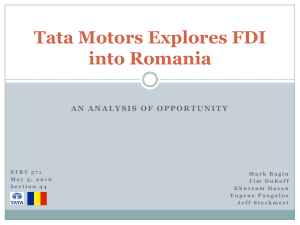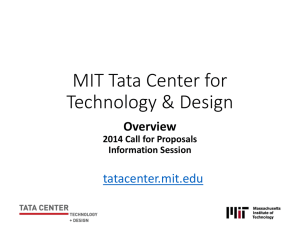Tata Motors - Rita Gunther McGrath
advertisement
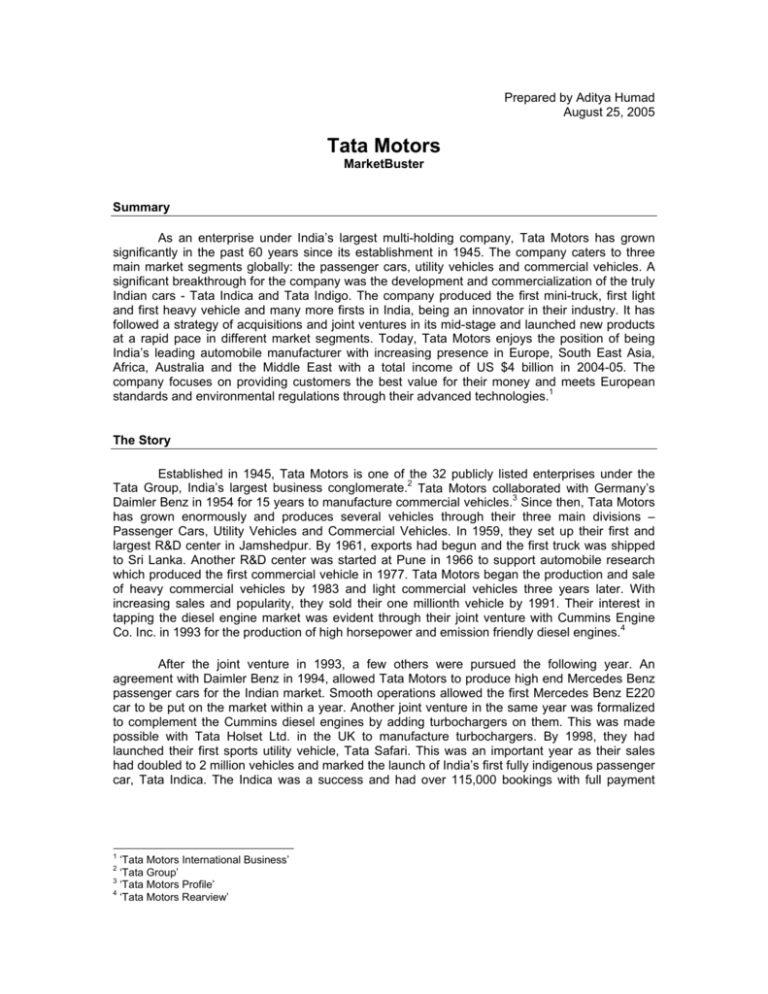
Prepared by Aditya Humad August 25, 2005 Tata Motors MarketBuster Summary As an enterprise under India’s largest multi-holding company, Tata Motors has grown significantly in the past 60 years since its establishment in 1945. The company caters to three main market segments globally: the passenger cars, utility vehicles and commercial vehicles. A significant breakthrough for the company was the development and commercialization of the truly Indian cars - Tata Indica and Tata Indigo. The company produced the first mini-truck, first light and first heavy vehicle and many more firsts in India, being an innovator in their industry. It has followed a strategy of acquisitions and joint ventures in its mid-stage and launched new products at a rapid pace in different market segments. Today, Tata Motors enjoys the position of being India’s leading automobile manufacturer with increasing presence in Europe, South East Asia, Africa, Australia and the Middle East with a total income of US $4 billion in 2004-05. The company focuses on providing customers the best value for their money and meets European standards and environmental regulations through their advanced technologies.1 The Story Established in 1945, Tata Motors is one of the 32 publicly listed enterprises under the Tata Group, India’s largest business conglomerate.2 Tata Motors collaborated with Germany’s Daimler Benz in 1954 for 15 years to manufacture commercial vehicles.3 Since then, Tata Motors has grown enormously and produces several vehicles through their three main divisions – Passenger Cars, Utility Vehicles and Commercial Vehicles. In 1959, they set up their first and largest R&D center in Jamshedpur. By 1961, exports had begun and the first truck was shipped to Sri Lanka. Another R&D center was started at Pune in 1966 to support automobile research which produced the first commercial vehicle in 1977. Tata Motors began the production and sale of heavy commercial vehicles by 1983 and light commercial vehicles three years later. With increasing sales and popularity, they sold their one millionth vehicle by 1991. Their interest in tapping the diesel engine market was evident through their joint venture with Cummins Engine Co. Inc. in 1993 for the production of high horsepower and emission friendly diesel engines.4 After the joint venture in 1993, a few others were pursued the following year. An agreement with Daimler Benz in 1994, allowed Tata Motors to produce high end Mercedes Benz passenger cars for the Indian market. Smooth operations allowed the first Mercedes Benz E220 car to be put on the market within a year. Another joint venture in the same year was formalized to complement the Cummins diesel engines by adding turbochargers on them. This was made possible with Tata Holset Ltd. in the UK to manufacture turbochargers. By 1998, they had launched their first sports utility vehicle, Tata Safari. This was an important year as their sales had doubled to 2 million vehicles and marked the launch of India’s first fully indigenous passenger car, Tata Indica. The Indica was a success and had over 115,000 bookings with full payment 1 ‘Tata Motors International Business’ ‘Tata Group’ 3 ‘Tata Motors Profile’ 4 ‘Tata Motors Rearview’ 2 within a year of the launch. The demand for the Indica was rising overseas as well, with a consignment of 160 vehicles shipped to Malta in 2000.5 The company’s ability to continually improve and innovate was seen in the following years when improved versions of their previous models were put into the market. The second generation Indica V2 and Tata Safari EX were launched and the Indica V2 soon took the top rank in India’s #1 car within its segment. In addition, to tackle environmental concerns, it launched the CNG (Compressed Natural Gas) buses and CNG Indica’s by 2001 that made use of compressed fuel tanks and significantly reduced toxic emissions. Sales had been increasing in all their commercial vehicle segments as well as passenger cars.6 In 2004, Tata signed an investment agreement with Daewoo Commercial Vehicle Co. Ltd. and later acquired the company. The new Tata Daewoo Company launched a heavy duty truck ‘Novus’ in Korean markets. It was also in 2004, that Tata Motors entered the US stock markets (NYSE: TTM).7 In the last few years, Tata produced more vehicles with other companies through joint ventures or acquisitions and presented many of its models at the Geneva Motor Show. Its latest model in trucks, also India’s first mini-truck, the Tata Ace was launched in 2005. Over the years, Tata has evolved in product line, global outreach, sales and become the leader in high performance and durable vehicles in many markets. MarketBusting Moves As India’s largest automobile manufacturer, Tata Motors entered the market and maintains its position using the following MarketBusting Moves: • • • • #2: Digitize to combine or replace links in an existing chain #20: Help improve your customers’ quality #28: Understand the Second-Order Effects of the Next Stage #37: Make a Land Grab #2: Digitize to combine or replace links in an existing chain Tata Motors entered a new agreement with Ariba Inc., the leading provider of spend management solutions in 2005. The company has realized significant bottom line savings after using Ariba spend management solutions for the past four years. Under this new agreement, Tata Motors has extended its commitment to Ariba Sourcing Services and Ariba QuickSource to drive additional cost reductions. The Ariba Spend Management platform has delivered rapid results in helping the company find new suppliers, rationalize its supply base, and run on-line markets. This has led to significant savings and the development of an effective supply chain. With rising costs and competition in the markets, managing spend and improving efficiency are key priorities for Tata Motors.8 #20: Help improve your customer’s quality Apart from providing its customers with high performance automobiles, Tata Motors strongly believes in customer safety. Several cases have been cited where passengers driving Tata vehicles have been saved after terrible accidents. Tata Motors established a crash-testing facility, the only one of its kind in the country, in Pune in 1996. The small workforce of 21 members including engineers aims to control the serious risks and intrusions in accidents. The company believes that this factor has been vital to the success of the Indica and other products 5 ‘Tata Motors Rearview’ Ibid 7 Ibid 8 ‘Tata Motors Extends Sourcing Partnership with Ariba’ 6 under the company’s passenger car unit. There are two complimentary aspects of crash testing: simulation, through powerful computers and sophisticated software, and the physical crashing of vehicles, at the prototyping stage. Project Manager for Vehicle Safety Systems, Anil Kumar says that, "The idea is to use every part of the vehicle in some way to save the occupant rather than the vehicle". After using advanced software and finite element analysis to sketch various scenarios and possible outcomes, a physical test is performed. The car is run at high-speeds into barriers of steel and concrete monitored by high-speed cameras taking about 1000 frames per second. Two crash-test dummies seated inside (Rs. 90lakh each) are wired to about 50 sensors with an additional 30 sensors in the car to record and monitor every element of the crash.9 Through years of experience, reported cases and the vast amount of resources expended by Tata Motors, they make sure that their customers are safe when driving their vehicles. #28: Understand the Second-Order Effects of the Next Stage India’s top selling sports utility vehicle, the Tata Safari has launched its latest power packed version, the Safari DICOR. The new model addresses many concerns from previous customers while providing comfort, style and performance. With rising oil prices and the desire for stressed city residents to take short vacations outside the city, the Safari DICOR provides the perfect combination. The indigenously developed direct injection common rail diesel engine delivers high power while a 32-bit microprocessor electronically monitors and controls pressure at the time of fuel injection into the engine, ensuring highly receptive and powerful performance with enhanced fuel efficiency. The Safari DICOR offers many luxury and comfort features like the powerful Blaunpunkt DVD/MP3 player with dual LCD screens and a mobile/laptop port for rear passengers. More importantly, its technologically advanced safety features include Antisubmarine seats, Anti-Lock Braking System (ABS) with Electronic Brake-Force Distribution (EBD), 3 stage collapsible steering column and front airbags for both the driver and co-driver. The unique reverse guide system facilitates rear visibility while reversing the vehicle.10 All these features have been incorporated through customer feedback, energy efficiency requirements and advanced safety measures. #37: Make a Land Grab The recent rains this month in Mumbai had caused heavy damage through out the region. The heavy rains turned into floods taking away people’s homes, cars and led to the loss of other public and private property. The frustrated customers have been helped by a bold move by the management of Tata Motors in wake of the rain damage. Tata has instructed all its dealers and service centers to offer a 25% discount on spare parts, labor charges, oil changes, rust treatment and up to 50% for Tata-branded audio and car security systems.11 The company has also asked centers to swiftly mobilize parts, provide prompt service and keep stores open for extended hours. Their comprehensive repair and relief support for owners of Tata vehicles has helped them further strengthen their customer relations and show that they care. 9 ‘Safety First’ ‘Tata Motors Press Release’ 11 Ibid 10 Key Lessons Tata Motors has proven excellence over the years through its technologically advanced products, market expansion, customer satisfaction and increasing sales. Tata Motors consistently strives to increase shareholder value, build stronger customer relations and work with its business partners to provide the best value for money. The company is also involved in accelerating the country’s economic growth and protecting the environment. With the initial financial backing of the giant parent company, Tata Group, the division has built a strong business over the past 60 years and continues to show strong financial results. The continual improvement and introduction of new products in the market have allowed it to successfully enter as well as dominate the automobile industry in India. With increasing sales, employees, product offerings, manufacturing facilities and distribution centers along with expansion outside India, the company seems to have a promising future. DRAT Table, Tata Motors SOURCE External Powerful Incumbents Stiff competition from domestic and international companies and adapting to changing needs of different market segments. Opposition from advocacy groups N/A Risk to key external stakeholders N/A Inertia Continuing to innovate and introduce new vehicles. Further expansion into global markets. Disruption of customer’s and system or process Maintain current customers and attract new segments through their superior technologically advanced products and quality service. Changes in standards or regulations required Regulations in different countries and environmental concerns. Internal Internal political maneuvering Company has overseeing board, senior management to handle the conglomerate’s many divisions. Reluctance or resistance by those needed for active implementation People comfortable with current products and service Resource Constraints N/A Platform changes required Human resource and skills platforms Greater expansion will require more employees globally. Logistics platforms Keep looking for cheaper and faster ways to deliver products to the consumer; increase the speed of the supply chain. Distributor platforms Expanding distribution, service centers. IT and database platforms Increased use of cost reduction, spend management solutions like Ariba to compete in the market. Technology platforms Constantly improving technology and R&D centers. Assets, operations, and systems platforms Increased interaction between the supply chain links to eliminate bottlenecks and deliver products faster to the consumer. Marketbusting Kite Element Needed to Support the Marketbusting System Agenda The key things that the critical people spend time on 1. 2. 3. 4. 1. 2. 3. 4. 1. 2. 3. Norms What principles and behaviors are valued? News What information and measures are paramount? Allocations What gets resourced and how are people rewarded? Structure Power, authority, responsibility structure History Key routines that have developed and drive activities Commitment to quality manufacturing standards Developing new products Customer Safety and satisfaction Global expansion High quality manufacturing Unparalleled customer satisfaction and service Technological innovation and proven quality Product Safety and brand image Customer and supplier feedback Indian market share and global segments Lead the industry and introduce products superior to competitors in a timely manner. Resources go to 1. Research for continual improvements 2. Cutting-edge technology and testing methods 3. Strategic acquisitions, joint ventures and marketing Rewards and recognition for successes go to 1. Innovative ideas and new products 2. Successful market entry and dominance 1. Large number of business units, few divisions 2. Overseen by board, senior management 1. Focusing on latest technology, customer preferences and needs 2. Innovation, excellence and technologically proven products 3. Building relations with distributors, suppliers and customers Sources • ‘Tata Motors International Business’. Retrieved: August 25, 2005 from <http://ib.tatamotors.com/value/index> • ‘Tata Group’. Retrieved: August 25, 2005 from <http://www.tata.com/0_about_us/group_profile.htm> • ‘Tata Motors Profile’. Retrieved: August 25, 2005 from <http://www.tatamotors.com/our_world/profile> • ‘Tata Motors Rearview’. Retrieved: August 25, 2005 from <http://www.tatamotors.com/our_world/rearview_text> • ‘Tata Motors Extends Sourcing Partnership with Ariba’ June 6, 2005, Ariba Press Release. Retrieved: August 25, 2005 from <http://www.ariba.com/company/press_archive.cfm> • Chacko, August 15, 2003, ‘Safety First’. Retrieved: August 25, 2005 from <http://www.domain-b.com/companies/companies_t/tata_motors/20030815_safety_first.htm> • ‘Tata Motors introduces the power packed – Safari Dicor’ August 3, 2005, Tata Motors Press Release. Retrieved: August 25, 2005 from <http://www.tatamotors.com/our_world/press_releases.php> • ‘Tata Motors mounts wide-ranging repair & relief support for owners of rain-damaged cars’ August 9, 2005, Tata Motors Press Release. Retrieved: August 25, 2005 from <http://www.tatamotors.com/our_world/press_releases.php>
